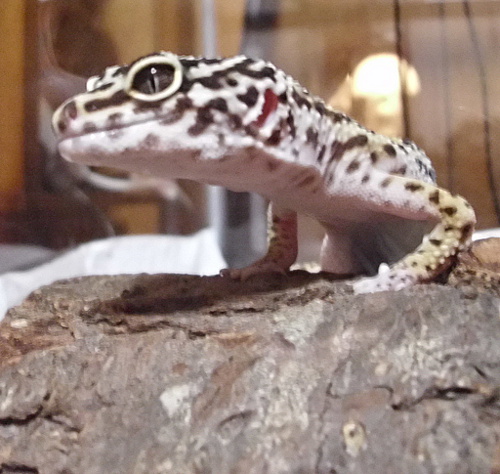indyana
Well-Known Member
- Messages
- 2,336
- Location
- Massachusetts, United States
Meet Amoré, the first leopard gecko I've had the pleasure of owning.
This gecko belonged to relatives originally. It was the all-too-familiar story of a young man who bought the pet and then lost interest, leaving it at his parents' house. While they were well-meaning people and by no means cruel, they simply did not have the time to adequately research and care for their new family member. I noticed this gecko was in very poor condition during a visit and gave them a few suggestions, but they were not able to devote the time needed by a sick animal. When I heard they were going on vacation, I offered to take the lizard and nurse him for a while.
He was very emaciated and appeared to be suffering from MBD. The owners reported he snapped at food but did not catch and eat it. Extremely weak and lethargic, he was unable to hold a struggling meal in his jaws and swallow it. His home was a 10-gallon tank with sand and a rock hide. There was an UTH that I thought was not putting out enough heat to penetrate the substrate adequately. He also had old, shed skin constricting all four feet and the lower half of his tail.
The first thing I did was dump the enclosure out, clean it, and switch to paper towels. I hooked a thermostat up to the UTH and set it to 90°F. Next up was a warm water soak to try and remove the shed skin. I then got him some smaller crickets and Repashy Leopard Gecko Calcium Plus. I had to pre-kill the crickets, dust them, and feed them to him with tongs for him to successfully swallow any, but he chomped down half a dozen in about five minutes.
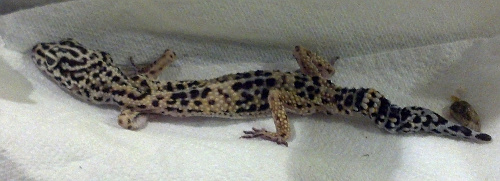
The above picture was taken July 12th, a few days after I first brought Amoré home. Most of the shed skin had been removed at this point. Looking at his flat little body, I worried he might be on his way out, but his eyes were so bright and alert that I had hope. His appetite seemed good, and, after pooping out a good amount of sand on his first day, the rest of his feces looked normal.
Over the next few weeks, I continued hand feeding him small crickets or mealworms dusted with supplement (which I smacked with a kitchen mallet first...). His appetite continued to increase until he was eating 20-30 small food items every other day. He started putting on weight and went through his first shed, revealing much brighter colors than I'm sure he'd worn in years. Unfortunately, he ended up losing most of his front toe tips as a result of the extended constriction, but he did not develop any infection as a result.
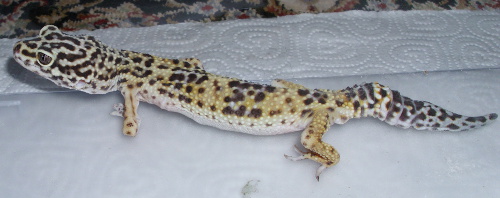
The above is July 25th, about two weeks after I got him. Slightly less flat and a lot more alert.
I continued the same routine. Eventually, I started disabling the insects instead of killing them outright. While he loved to chase a moving target, his hunting ability remained fairly pathetic, so after he'd gotten tired, I would hand feed until he was full. His energy continued to improve, and he even started getting a bit of muscle on his hind legs, which recovered well. His front legs still remained oddly bendy, but his jaw improved to the point where he began actually crunching on his food.
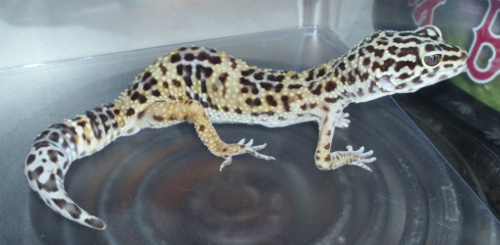
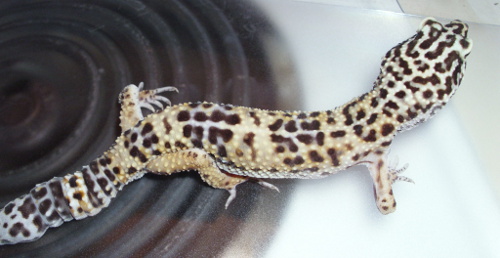
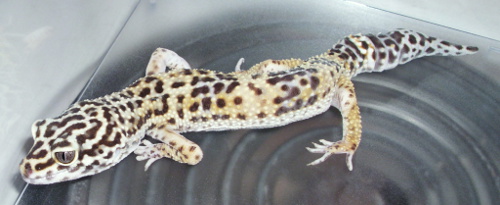
These pictures are from August 15th, a little over a month after I brought Amoré home. At this point, I thought to weigh him on my kitchen scale, which reported him in at 48g (not sure how exact that is...).
He's doing very well, although his front legs continue to get away from him at times. He looks even better now, so I'll try to post some updated pictures soon. I let him hunt a bit at each feeding, but I'm starting to think he's always going to need to be fed with tongs, as he is a terrible hunter still. Right now he's alternating between crickets and mealworms, but I plan to try out some different feeders in the future. He still eats 20-30 insects per feeding. I'm sizing cautiously, with crickets 1/2"-3/4" and mealworms 3/4"-1". He's probably strong enough to get down some larger prey at this point.
After a short discussion, his previous owners were more than happy to let me keep him. They seemed relieved more than anything.
The "him" is not confirmed yet, although I'll take another crack at looking when he's a bit more comfortable being handled. We're working on it...
This gecko belonged to relatives originally. It was the all-too-familiar story of a young man who bought the pet and then lost interest, leaving it at his parents' house. While they were well-meaning people and by no means cruel, they simply did not have the time to adequately research and care for their new family member. I noticed this gecko was in very poor condition during a visit and gave them a few suggestions, but they were not able to devote the time needed by a sick animal. When I heard they were going on vacation, I offered to take the lizard and nurse him for a while.
He was very emaciated and appeared to be suffering from MBD. The owners reported he snapped at food but did not catch and eat it. Extremely weak and lethargic, he was unable to hold a struggling meal in his jaws and swallow it. His home was a 10-gallon tank with sand and a rock hide. There was an UTH that I thought was not putting out enough heat to penetrate the substrate adequately. He also had old, shed skin constricting all four feet and the lower half of his tail.
The first thing I did was dump the enclosure out, clean it, and switch to paper towels. I hooked a thermostat up to the UTH and set it to 90°F. Next up was a warm water soak to try and remove the shed skin. I then got him some smaller crickets and Repashy Leopard Gecko Calcium Plus. I had to pre-kill the crickets, dust them, and feed them to him with tongs for him to successfully swallow any, but he chomped down half a dozen in about five minutes.

The above picture was taken July 12th, a few days after I first brought Amoré home. Most of the shed skin had been removed at this point. Looking at his flat little body, I worried he might be on his way out, but his eyes were so bright and alert that I had hope. His appetite seemed good, and, after pooping out a good amount of sand on his first day, the rest of his feces looked normal.
Over the next few weeks, I continued hand feeding him small crickets or mealworms dusted with supplement (which I smacked with a kitchen mallet first...). His appetite continued to increase until he was eating 20-30 small food items every other day. He started putting on weight and went through his first shed, revealing much brighter colors than I'm sure he'd worn in years. Unfortunately, he ended up losing most of his front toe tips as a result of the extended constriction, but he did not develop any infection as a result.

The above is July 25th, about two weeks after I got him. Slightly less flat and a lot more alert.
I continued the same routine. Eventually, I started disabling the insects instead of killing them outright. While he loved to chase a moving target, his hunting ability remained fairly pathetic, so after he'd gotten tired, I would hand feed until he was full. His energy continued to improve, and he even started getting a bit of muscle on his hind legs, which recovered well. His front legs still remained oddly bendy, but his jaw improved to the point where he began actually crunching on his food.



These pictures are from August 15th, a little over a month after I brought Amoré home. At this point, I thought to weigh him on my kitchen scale, which reported him in at 48g (not sure how exact that is...).
He's doing very well, although his front legs continue to get away from him at times. He looks even better now, so I'll try to post some updated pictures soon. I let him hunt a bit at each feeding, but I'm starting to think he's always going to need to be fed with tongs, as he is a terrible hunter still. Right now he's alternating between crickets and mealworms, but I plan to try out some different feeders in the future. He still eats 20-30 insects per feeding. I'm sizing cautiously, with crickets 1/2"-3/4" and mealworms 3/4"-1". He's probably strong enough to get down some larger prey at this point.
After a short discussion, his previous owners were more than happy to let me keep him. They seemed relieved more than anything.
The "him" is not confirmed yet, although I'll take another crack at looking when he's a bit more comfortable being handled. We're working on it...

